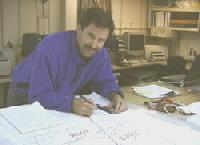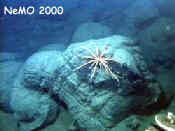| |
Participant
Interview:
Bill
Chadwick
Geologist
Oregon State University/NOAA Vents Program
Jeff: How did you get interested
in volcano monitoring?
Bill: In college I was a field assistant at Mt. St. Helens. We flew helicopters
into the crater and there was an eruption while I was there. It totally
blew my mind. I walked around in the crater and there was lots of steam
and glowing cracks in the floor of the volcano. It was a blast.
Jeff: As a geologist, what
are your responsibilities on this cruise?
Bill: I do a little of everything. I oversee the acoustic navigation.
I'm collecting the Imagenex data (high
resolution bathymetry). I'm also researching the geology of the eruption
site with Bob Embley and John Chadwick (no relation). We're still working
on mapping out the 1998 lava flow, especially to the south. I've also
worked on the seafloor monitoring instruments, including the extensometers
that measure horizontal deformation of the volcano and bottom pressure
recorders that measure vertical deformation.
Jeff: Why measure deformation
of the volcano?
Bill: Deformation monitoring is one of the main techniques to help geologists
determine what the magma is doing underground. My research involves using
volcano monitoring methods from land-based geological research at Axial
volcano. It's really challenging because it's a lot harder to work on
the sea floor. On land, you just drive out in your car and plop an instrument
down. Out here, the ocean floor environment is unforgiving so there's
many things that can go wrong.
Jeff: Why is Axial so interesting
geologically?
Bill: Since it's a hot spot, it erupts frequently and has the largest
magma supply on the Juan de Fuca Ridge. On the ridge itself we wouldn't
see this type of inflation and deflation. So, it's a good place to try
initial underwater monitoring. Axial is interesting because it might behave
like some of the well known basaltic volcanoes in Iceland and Hawaii.
The neat thing about the research we're doing is that 10 years ago no
one had ever detected, studied, or known about a mid-ocean ridge eruption.
The 1998
Axial eruption was the first time monitoring instruments recorded
an eruption. It's really cool. That's where the fun comes in. You feel
like your really participating in a discovery. It's really a frontier
in marine science.
|
|

Bill Chadwick reviewing
the 1998 lava flow map in the computer lab.

Older pillow basalt with a crinoid on top.
|
|

